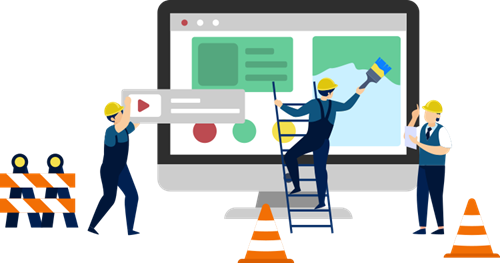Last Modified: 1/7/24
One of the most overlooked aspects of running strong performing digital marketing campaigns is how to craft the perfect landing page so that prospects clicking on your ads are presented with a compelling landing page which maximizes the potential to convert them to a lead or ecommerce purchase.

-
Why can’t I just link all of my ads to the contact us page?
For lead generation campaigns this is probably one of the most common setups (and most ineffective) we see when first auditing a digital campaign. Upon clicking the ad, a prospect will be sent straight to the contact us page which typically has a contact form or an email and phone number. The problem here is that you’ve only given that prospect half the story and nothing that drives them further to explore your product or service. Try to always look at the first stages of your funnel from the perspective of the customer, like the following example:
- Your ad gets the prospect’s attention
- The prospect clicks through to your site, curious about your offering
- They are lead to a contact us page that doesn’t give them any additional information about your products or services and they bounce
To effectively change the outcome of the above example it almost always makes the most sense to build a custom landing page that builds upon the curiosity you’re creating in the ad creative. Take a look at our 10 step guide for building better converting Google Ad campaigns.
-
Where should we build the landing page?
So we now understand why there is a need for a landing page, but where should this actually be built and on what platform? There are hundreds of different web platforms and custom built websites that aren’t always the easiest for marketers to build new content on. This is where tools specifically developed to give digital marketers the ability to easily build out custom landing pages might make sense.
- Is your web platform, or CMS (content-management-system) easy to build new web pages on?
- How quickly can you create those landing pages?
- Do you need additional resources, such as a developer, to get this done?
- Can you set up tracking and analytics properly to show accurate conversions?
If your in-house marketers or agency isn't able to quickly build landing pages for digital campaigns, you have a few options: replatform to a friendlier CMS, use a 3rd party tool like Unbounce, or hire a developer to create a few marketing friendly templates on your current web platform.
A high-quality agency can create landing pages and set up analytics on any web platform, although some are easier than others. You’ll find plenty of agencies who are great in Wordpress, Wix, Squarespace and Weebly but get lost in more enterprise platforms like Episerver, Sitecore, Drupal, Umbraco, or Adobe Experience Manager.
-
Do you need multiple different versions of the landing page?
It’s common to run a digital ad campaign that might target multiple unique audiences, whether this is based on the Google Ad keywords you’re bidding on or the demographics of the targeting in paid social. In this situation you have several options:
- Build one general landing page to appeal to a wider audience and accept a lower conversion rate
- Build multiple landing pages each targeted specifically at the audience your keywords relate to
- Build one page and use a dynamic content platform like Optimizely or Google Optimize to change images, titles, and body copy based on the audience
The option using dynamic content is a great solution and our favorite, although it does require some expertise to do it right.

-
Types of landing pages: evergreen, hybrid, or dark?
Depending on how the digital campaign is setup, the landing pages you create can be structured several different ways as seen below:
- Navigable on your site, indexed by search engines (evergreen)
- Not navigable on your site, indexed by search engines (hybrid)
- Not navigable on your site, not indexed by search engines (dark)
Evergreen campaigns usually revolve a core focus of your product and service and will almost always be running in some shape or form in your marketing. Hybrid landing pages might be something like a product comparison page with a competitor, where you might not want it in your navigation but you still want to generate organic traffic from search engines. Dark landing pages don’t exist in your site’s navigation or are indexed by search engines, these pages are typically hyper-targeted at a specific audience that you would not want an average user to visit.
If you’re building multiple versions of the same landing page and the content isn’t strongly differentiated you might get a duplicate content penalty. You can easily avoid this by adding a “noindex” directive in the page meta.
-
How much content do I need on these landing pages?
The simple answer is enough content to compel your prospect to complete whatever the goal of your campaign is. If you’re running a newsletter signup campaign, it might make sense to have a few bullets of the core benefits to why they should signup and an image or two with a single field email form.
However, if you’re selling a complex product or service the prospect might want a greater amount of detail and you’d benefit from additional content and linking off to case studies or customer profiles might be smart.
-
Keep the page clean and distraction free
Avoid overloading your landing pages with distracting elements like GIFs or unnecessary videos not relevant to the prospect. Keeping the page clean and simple will allow it to load quicker and more easily allow the prospect to focus on your value proposition versus getting sidetracked by fancy animations.
-
Create urgency in your call to action
Help nudge prospects into your lead funnel by creating urgency around why they need your product or service, what are the immediate benefits and value they will get? It also helps to tell them exactly what they need to do such as filling out the form below and clicking submit, it really is sometimes that simple.
-
Know when to seek outside help
It’s easy to want to do everything yourself to save on some costs, but remember that the longer your campaigns take to plan and build, the greater is the opportunity cost in not seeking out expert assistance to start generating those leads quicker.
Not sure where to start?
At jumpany we’ve helped startups through Fortune 500 companies build out effective digital campaigns so we know a thing or two about digital landing page strategy. Schedule a free consultation with us today.